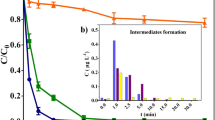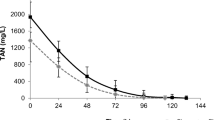Abstract
In our study, we determined and compared the atrazine-biodetoxification ability of 41 bacterial strains and 21 consortia created of those with over 50% degradation rate in pure cultures. Biodegradation capacity was measured with GC-MS. Detoxification was assessed based on the cytotoxic effect of end-products to Aliivibrio fischeri in chronic bioluminescence inhibition assay with 25 h contact time. Chronic A. fischeri assay adapted to a microplate, which is suitable for examine numerous residues simultaneously, also appeared to be significantly more sensitive to atrazine compared to the standard acute (30 min) test. Due to its sensitivity, the chronic assay could be a valuable tool to provide a more comprehensive view of the ecological risks of atrazine and other chemicals. Thirteen strains were able to degrade more than 50% of 50 ppm atrazine. Four of these belong to Rhodococcus aetherivorans, R. qingshengii, Serratia fonticola and Olivibacter oleidegradans which species’ atrazine degrading ability has never been reported before. Four consortia degrading ability was more effective than that of the creating individual strains; moreover, their residues did not show cytotoxic effects to A. fischeri. However, in several cases, the degradation products of sole strains and consortia resulted in significant bioluminescence inhibition. Thus high biodegradation (>90%) does not certainly mean the reduction or cessation of toxicity highlighting the importance of the evaluation of biological effects of degradation residues to improve the efficiency and abate the ecological risks of bioremediation techniques.


Similar content being viewed by others
References
Aislabie J, Bej AK, Ryburn J et al. (2005) Characterization of Arthrobacter nicotinovorans HIM, an atrazine-degrading bacterium, from agricultural soil New Zealand. FEMS Microbiol Ecol 52:279–286. doi:10.1016/j.femsec.2004.11.012
Behki R, Topp E, Dick W, Germon P (1993) Metabolism of the herbicide atrazine by rhodococcus strains. Appl Environ Microbiol 59:1955–1959
Behki RM, Khan SU (1994) Degradation of atrazine, propazine, and simazine by Rhodococcus strain B-30. J Agric Food Chem 42:1237–1241. doi:10.1021/jf00041a036
Cai B, Han Y, Liu B et al. (2003) Isolation and characterization of an atrazine-degrading bacterium from industrial wastewater in China. Lett Appl Microbiol 36:272–276. doi:10.1046/j.1472-765X.2003.01307.x
Cook AM, Hüter R (1984) Deethylsimazine: bacterial dechlorination, deamination, and complete degradation. J Agric Food Chem 32(3):581–585
Cook AM, Hütter R (1986) Ring dechlorination of deethylsimazine by hydrolases from Rhodococcus corallinus. FEMS Microbiol Lett 34(3):335–338
Fazlurrahman H, Batra M, Pandey J et al. (2009) Isolation and characterization of an atrazine-degrading Rhodococcus sp. strain MB-P1 from contaminated soil. Lett Appl Microbiol 49:721–729. doi:10.1111/j.1472-765X.2009.02724.x
Feakin SJ, Blackburn E, Burns RG (1995) Inoculation of granular activated carbon in a fixed bed with S-triazine-degrading bacteria as a water treatment process. Water Res 29:819–825. doi: 10.1016/0043-1354(94)00209-P
Forson DD, Storfer A (2006) Atrazine increases Ranavirus susceptibility in the tiger salamander, Ambystoma tigrinum. Ecol Appl 16:2325–2332. doi:10.1890/1051-0761(2006)016[2325:AIRSIT]2.0.CO;2
Froehner K, Meyer W, Grimme LH (2002) Time-dependent toxicity in the long-term inhibition assay with Vibrio fischeri. Chemosphere 46:987–997. doi: 10.1016/S0045-6535(01)00209-0
Getenga Z, Dörfler U, Iwobi A et al. (2009) Atrazine and terbuthylazine mineralization by an Arthrobacter sp. isolated from a sugarcane-cultivated soil in Kenya. Chemosphere 77:534–539. doi:10.1016/j.chemosphere.2009.07.031
Ghosh P, Philip L (2006) Environmental significance of atrazine in aqueous systems and its removal by biological processes : an overview. Glob NEST J 8:159–178
Hayes TB, Collins A, Lee M et al. (2002) Hermaphroditic, demasculinized frogs after exposure to the herbicide atrazine at low ecologically relevant doses. Proc Natl Acad Sci USA 99:5476–5480. doi:10.1073/pnas.082121499
Hayes TB, Khoury V, Narayan A et al. (2010) Atrazine induces complete feminization and chemical castration in male African clawed frogs (Xenopus laevis). Proc Natl Acad Sci 107:4612–4617. doi:10.1073/pnas.0909519107
Hernando MD, De Vettori S, Martínez Bueno MJ, Fernández-Alba AR (2007) Toxicity evaluation with Vibrio fischeri test of organic chemicals used in aquaculture. Chemosphere 68:724–730. doi:10.1016/j.chemosphere.2006.12.097
ISO 11348-1 (2007) Water quality – Determination of the inhibitory effect of water samples on the light emission of Vibrio fischeri (Luminescent bacteria test) – Part 1: Method using freshly prepared bacteria, 2007-12, International Organization for Standardization, Geneva, Switzerland. https://www.iso.org/standard/40516.html
Jablonowski ND, Schäffer A, Burauel P (2011) Still present after all these years: persistence plus potential toxicity raise questions about the use of atrazine. Environ Sci Pollut Res 18:328–331. doi:10.1007/s11356-010-0431-y
Köck M, Farré M, Martínez E et al. (2010) Integrated ecotoxicological and chemical approach for the assessment of pesticide pollution in the Ebro river delta (Spain). J Hydrol 383:73–82. doi:10.1016/j.jhydrol.2009.12.029
Korpraditskul R, Katayama A, Kuwatsuka S (1993) Degradationof atrazine by soil bacteria in the stationary phase. J Pesticide Sci 18:293–298
Krifaton C, Kriszt B, Szoboszlay S et al. (2011) Analysis of aflatoxin-B1-degrading microbes by use of a combined toxicity-profiling method. Mutat Res - Genet Toxicol Environ Mutagen 726:1–7. doi:10.1016/j.mrgentox.2011.07.011
Larkin MJ, Kulakov LA, Allen CC (2005) Biodegradation and Rhodococcus – masters of catabolic versatility. Curr Opin Biotechnol 16:282–290. doi:10.1016/j.copbio.2005.04.007
Mandelbaum RT, Allan DL, Wackett LP (1995) Isolation and characterization of a Pseudomonas sp. that mineralizes the s-triazine herbicide atrazine. Appl Environ Microbiol 61:1451–1457
Mandelbaum RT, Wackett LP, Allan DL (1993) Mineralization of the s-triazine ring of atrazine by stable bacterial mixed cultures. Appl Environ Microbiol 59:1695–1701. doi:10.1007/s10533-010-9481-y
Martinez B, Tomkins J, Wackett LP et al. (2001) Complete nucleotide sequence and organization of the atrazine catabolic plasmid pADP-1 from Pseudomonas sp. strain ADP. J Bacteriol 183:5684–5697. doi:10.1128/JB.183.19.5684
Miyashiro T, Ruby EG (2012) Shedding light on bioluminescence regulation in Vibrio fischeri. Mol Microbiol 84(5):795–806. doi:10.1111/j.1365-2958.2012.08065.x
Mudhoo A, Garg VK (2011) Sorption, transport and transformation of atrazine in soils, minerals and composts: a review. Pedosphere 21:11–25. doi: 10.1016/S1002-0160(10)60074-4
Nagy I, Compernolle F, Ghys K et al. (1995) A single cytochrome P-450 system is involved in degradation of the herbicides EPTC (S-ethyl dipropylthiocarbamate) and atrazine by Rhodococcus sp. strain NI86/21. Appl Environ Microbiol 61:2056–2060
Oka T, Tooi O, Mitsui N et al. (2008) Effect of atrazine on metamorphosis and sexual differentiation in Xenopus laevis. Aquat Toxicol 87:215–226. doi:10.1016/j.aquatox.2008.02.009
Ostrofsky EB, Robinson JB, Traina SJ, Tuovinen OH (2002) Analysis of atrazine-degrading microbial communities in soils using most-probable-number enumeration, DNA hybridization, and inhibitors. Soil Biol Biochem 34:1449–1459. doi: 10.1016/S0038-0717(02)00089-5
Palma P, Palma VL, Fernandes RM et al. (2008) Acute toxicity of atrazine, endosulfan sulphate and chlorpyrifos to Vibrio fischeri, Thamnocephalus platyurus and Daphnia magna, relative to their concentrations in surface waters from the Alentejo region of Portugal. Bull Environ Contam Toxicol 81:485–489. doi:10.1007/s00128-008-9517-3
Piutti S, Semon E, Landry D et al. (2003) Isolation and characterisation of Nocardioides sp. SP12, an atrazine-degrading bacterial strain possessing the gene trzN from bulk- and maize rhizosphere soil. FEMS Microbiol Lett 221:111–117. doi: 10.1016/S0378-1097(03)00168-X
Ralebitso TK, Senior E, van Verseveld HW (2002) Microbial aspects of atrazine degradation in natural environments. Biodegradation 13:11–19. doi:10.1023/A:1016329628618
Ralston-Hooper K, Hardy J, Hahn L et al. (2009) Acute and chronic toxicity of atrazine and its metabolites deethylatrazine and deisopropylatrazine on aquatic organisms. Ecotoxicology 18:899–905. doi:10.1007/s10646-009-0351-0
Rousseaux S, Hartmann A, Soulas G (2001) Isolation and characterisation of new Gram-negative and Gram-positive atrazine degrading bacteria from different French soils. FEMS Microbiol Ecol 36:211–222. doi: 10.1016/S0168-6496(01)00135-0
Sass JB, Colangelo A (2006) European Union bans atrazine, while the United States negotiates continued use. Int J Occup Environ Health 12:260–267. doi:10.1179/oeh.2006.12.3.260
Shao ZQ, Behki R (1996) Characterization of the expression of the thcB gene, coding for a pesticide-degrading cytochrome P-450 in Rhodococcus strains. Appl Environ Microbiol 62:403–407
Shelton DR, Khader S, Karns JS, Pogell BM (1996) Metabolism of twelve herbicides by Streptomyces. Biodegradation 7:129–136
Smith D, Alvey S, Crowley DE (2005) Cooperative catabolic pathways within an atrazine-degrading enrichment culture isolated from soil. FEMS Microbiol Ecol 53:265–273. doi:10.1016/j.femsec.2004.12.011
Solomon RDJ, Kumar A, Satheeja Santhi V (2013) Atrazine biodegradation efficiency, metabolite detection, and trzD gene expression by enrichment bacterial cultures from agricultural soil. J Zhejiang Univ Sci B 14:1162–1172. doi:10.1631/jzus.B1300001
Soltanian S (2016) Effect of atrazine on immunocompetence of red-eared slider turtle (Trachemys scripta). J Immunotoxicol 13(6):804–809. doi:10.1080/1547691X.2016.1195463
de Souza ML, Newcombe D, Alvey S et al. (1998) Molecular basis of a bacterial consortium: interspecies catabolism of atrazine. Appl Envir Microbiol 64:178–184
Stamper DM, Radosevich M, Hallberg KB et al. (2002) Ralstonia basilensis M91-3, a denitrifying soil bacterium capable of using s-triazines as nitrogen sources. Can J Microbiol 48:1089–1098. doi:10.1139/w02-113
Struthers JK, Jayachandran K, Moorman TB (1998) Biodegradation of atrazine by Agrobacterium radiobacter J14a and use of this strain in bioremediation of contaminated soil. Appl Environ Microbiol 64:3368–3375
Tchounwoul PB, Wilson B, Ishaque A et al. (2000) Toxicity assessment of atrazine and related triazine compounds in the Microtox Assay, and computational modeling for their structure-activity relationship. Int J Mol Sci 1:63–74. doi:10.3390/ijms1040063
Topp E, Zhu H, Nour SM et al. (2000) Characterization of an atrazine-degrading Pseudaminobacter sp. isolated from Canadian and French agricultural soils. Appl Environ Microbiol 66:2773–2782. doi:10.1128/AEM.66.7.2773-2782.2000
Vaishampayan PA, Kanekar PP, Dhakephalkar PK (2007) Isolation and characterization of Arthrobacter sp. strain MCM B-436, an atrazine-degrading bacterium, from rhizospheric soil. Int Biodeterior Biodegrad 60:273–278. doi:10.1016/j.ibiod.2007.05.001
WHO (2011) Atrazine and its metabolites in drinking-water. Background documents for development of WHO Guidelines for drinking-water quality. http://www.who.int/water_sanitation_health/dwq/chemicals/antrazine.pdf. Accessed 10 Jan 2017
Yanze-Kontchou C, Gschwind N (1994) Mineralization of the herbicide atrazine as a carbon source by a Pseudomonas strain. Appl Environ Microbiol 60:4297–4302. doi:10.1021/jf00056a061
Zhang Y, Cao B, Jiang Z et al. (2012) Metabolic ability and individual characteristics of an atrazine-degrading consortium DNC5. J Hazard Mater 237–238:376–381. doi:10.1016/j.jhazmat.2012.08.047
Zhang Y, Jiang Z, Cao B et al. (2011) Metabolic ability and gene characteristics of Arthrobacter sp. strain DNS10, the sole atrazine-degrading strain in a consortium isolated from black soil. Int Biodeterior Biodegrad 65:1140–1144. doi:10.1016/j.ibiod.2011.08.010
Acknowledgements
This study was supported by the GINOP 2.3.2.-15-2016-00004 and Research Centre of Excellence—1476-4/2016/FEKUT project.
Author information
Authors and Affiliations
Corresponding author
Ethics declarations
Conflict of interest
The authors declare that they have no competing interests.
Ethical approval
This article does not contain any studies with human participants or animals performed by any of the authors.
Rights and permissions
About this article
Cite this article
Háhn, J., Szoboszlay, S., Tóth, G. et al. Assessment of bacterial biodetoxification of herbicide atrazine using Aliivibrio fischeri cytotoxicity assay with prolonged contact time. Ecotoxicology 26, 648–657 (2017). https://doi.org/10.1007/s10646-017-1797-0
Accepted:
Published:
Issue Date:
DOI: https://doi.org/10.1007/s10646-017-1797-0




